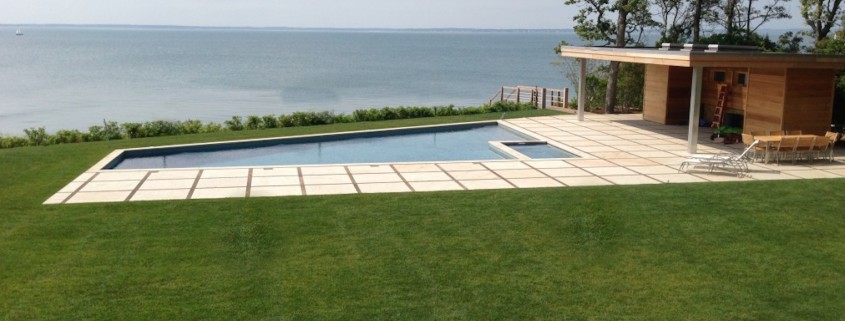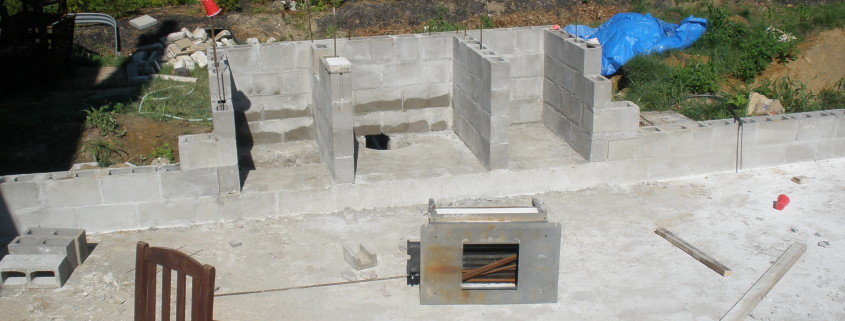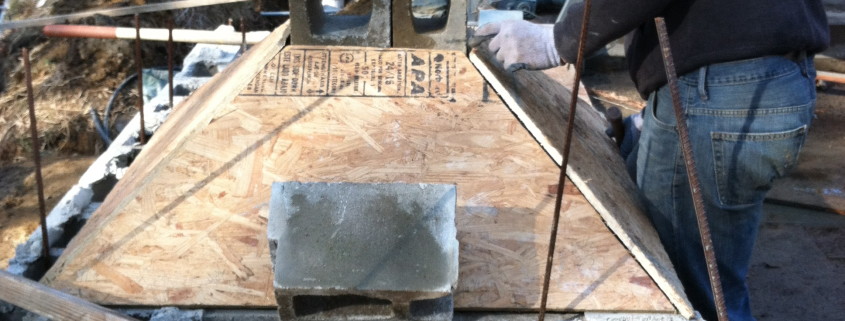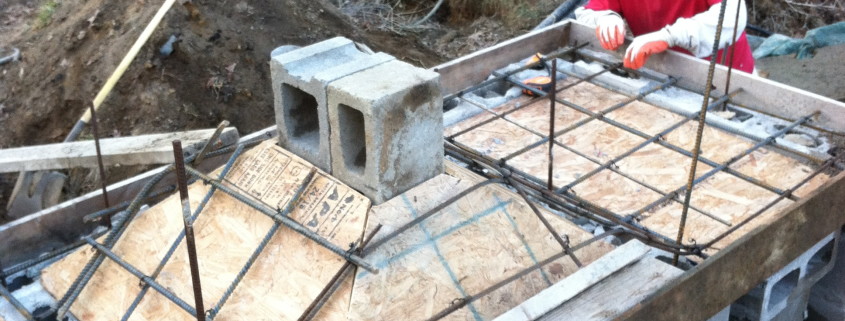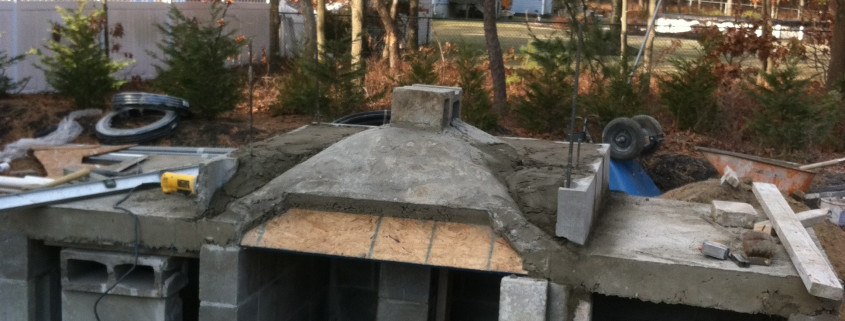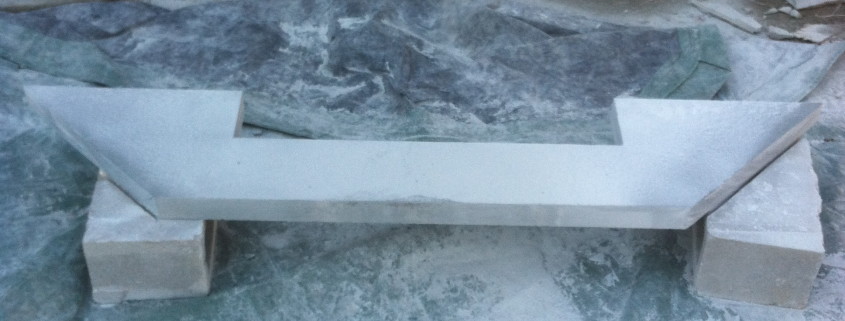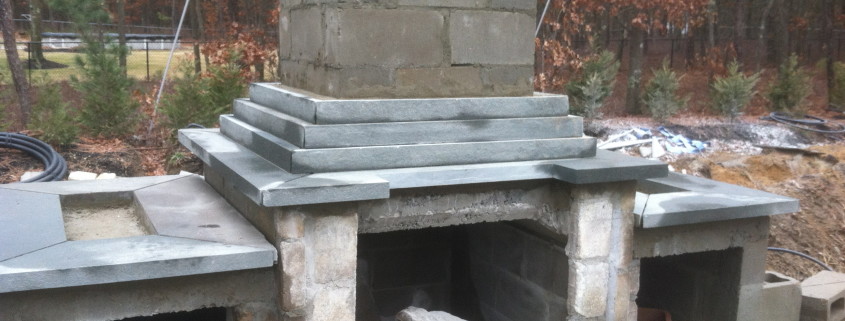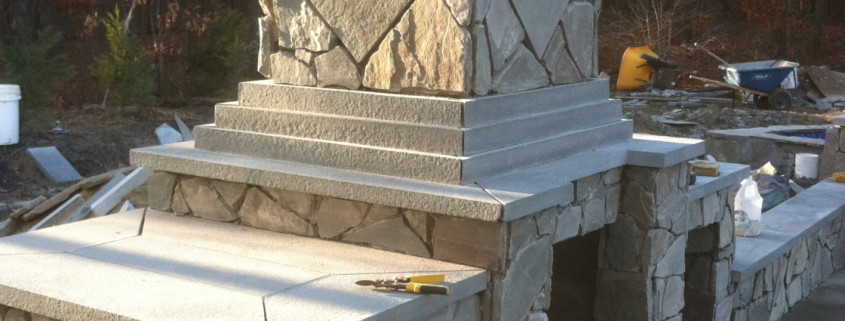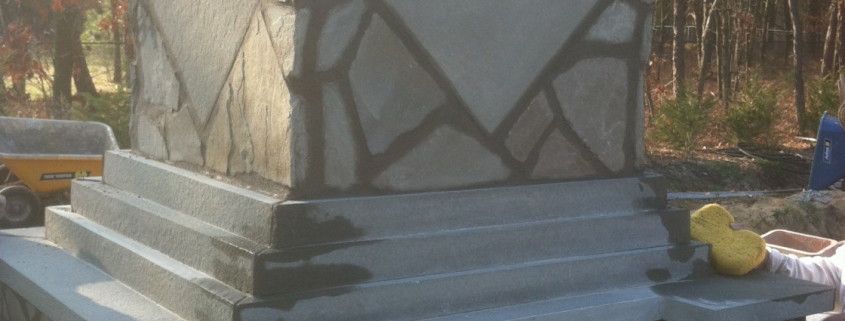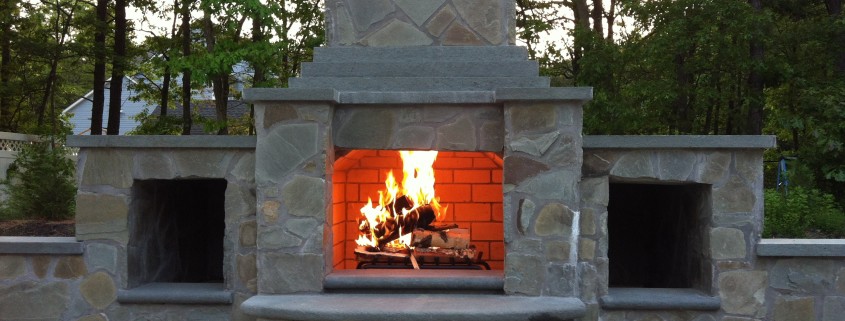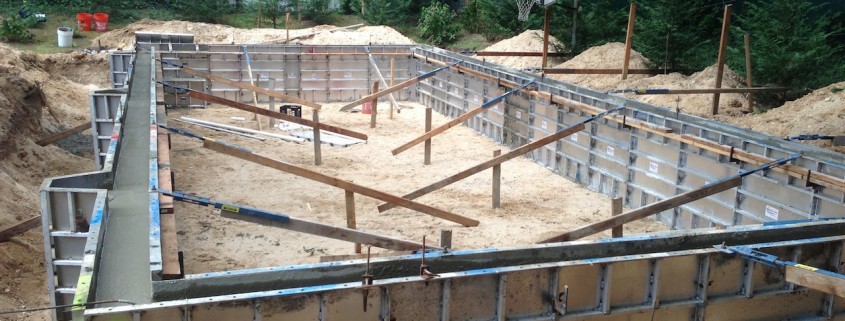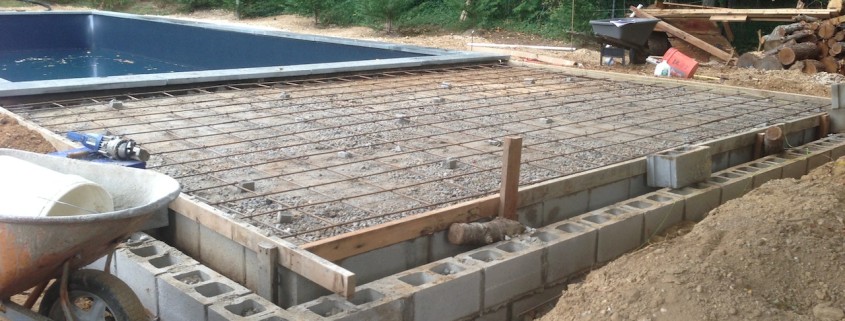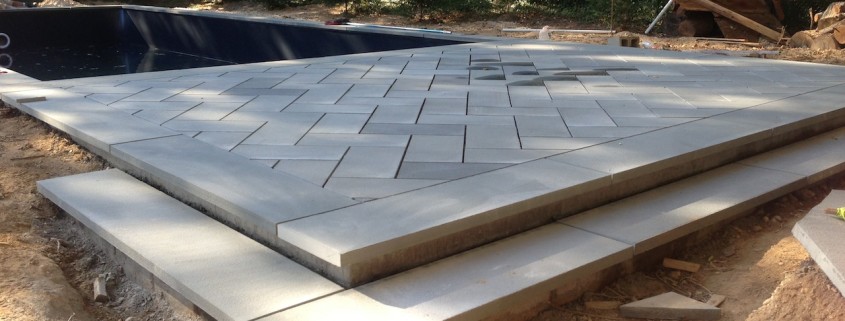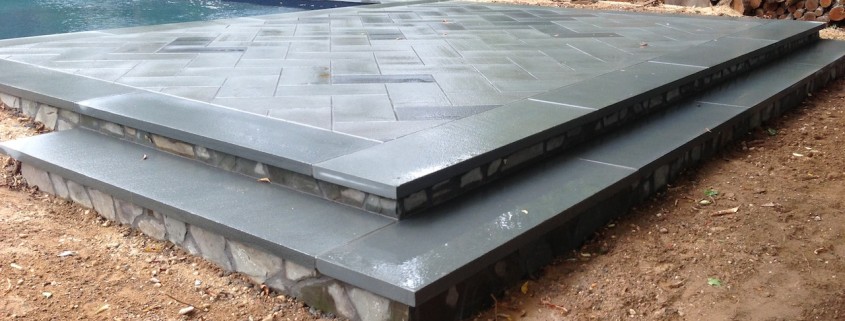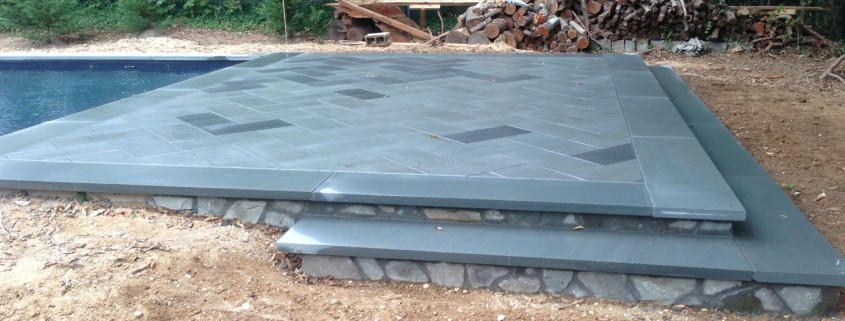3D pool project design – See your pool before it’s built
/in Blog /by Patrick Kenney
Our 3D pool design software lets our customers get a very accurate idea of what their pool project will look like in their own back yard. Above we have a real life example of our 3D pool design compared with the actual pool we built. The phrase a picture is worth a thousand words is accurate in this instance. Our software allows our customers to make changes to their projects and see what options they want to include in the final construction plan. They can also see a variety of different pool designs on their own back yard to see what they like best. This system allows our customers to be confident that they are purchasing exactly what they want.
Patrick Kenney is a Southampton pool contractor
Suffolk County pool & stone masonry step by step mini project
/in Blog /by Patrick KenneyWhat is cooler than a really nice pool and patio? A really nice pool and patio that also has FIRE!
By Patrick Kenney, a Southampton pool installer:
In this step-by-step mini project I will walk you through our steps for building this one of a kind outdoor fireplace custom made using Colonial Blue Wallstone, Indian Sandstone, and Pennsylvania Bluestone. The object of this build was to make a fireplace with a good amount of ornate detail, similar to the “paver kit” fireplaces that can be purchased as a step by step kit that includes all parts needed, except we wanted to do this ourselves using unfinished stone. This means we would cut and finish each piece of stone in this project to make it what we need to build the fireplace.
The first step in this project is to make a good footing. At Patrick’s Pools, any masonry structure that we make that comes vertically off the ground will always start with a footing that is 30 inches deep within the ground. This may sound ridiculous to a novice but to someone who knows a bit about masonry here in the Northeast, this will sound like a very well built foundation. The reason to go down 30 inches before building up at all, is to start the structure beneath the frost line. Any concrete structure that starts higher than 30″ within the ground will at some point, on some very cold day, have the ground freeze beneath it. When this happens the structure will heave (move) upwards. This is when cracking can occur since the structure may not move evenly. A good foundation is very important. The second step in our project is to build the walls for our fireplace and wood cubbies. We also left a “trap door” exit in the back of the wall and floor for easy future ash cleanup.
Next we build forms for our tops of wood cubbies and fireplace. We support or forms from beneath. They will be pulled out once the concrete tops have cured. The top walls of the fireplace chamber need to be angled less than 45 degrees downward in order to hold up the flue pipe and chimney weight long term.
It is very important that the top of the firebox chamber and top of the cubby holes are strong. The top walls of the firebox chamber need to hold up the massive weight of the flue pipe and chimney, and the wood cubbies at some point will most likely have heavy planters sitting on them, not to mention people walking on them. To give the concrete the strength it needs we install a 1/2″ rebar cage, just as we would while building a gunite pool.
Next step is to pour our proprietary concrete blend on our forms to create our chamber and wood cubby tops.
Next remove our forms and install our flue pipe and chimney.
Next we custom cut all of our Pennsylvania Bluestone to create our Crown, Mantel shelf, and Hearth. The Crown and Hearth were cut into shape then rounded using a cup wheel. All of our cut stone was then textured by running a thermal torch over it to get rid of any evidence that it was cut with a blade. Below is out custom Mantel Shelf.
Here we have installed our custom made Mantel Shelf and our Bluestone coping tops for the wood cubbies.
Next we install our Colonial Blue Wall Stone as a veneer on the fireplace. We install a diamond shaped Indian Sand Stone on all four sides of our chimney as an accent within the wall stone.
Our final step is to fill between our Colonial Blue Wall Stone with our dyed grout mixture.
Here is the finished product. A beautiful fireplace created completely out of natural stone by Patricks Pools Inc. This poolside fireplace is an amazing relaxation in the late afternoon or early evening. A great place for the family or friends to gather around and relax.
Long Island pool & bluestone patio installation-step by step mini project
/in Blog /by Patrick KenneyUNDER CONSTRUCTION:
Patrick Kenney of Southampton, NY, Pool installation:
Vinyl pool and bluestone patio installation – Gunite pool look-a-like
Working with natural stone is my favorite part of pool construction. I enjoy knowing that the material I am using to create a beautiful pool landscape, is something that has been created over millions of years and was cut from a mountain side somewhere. Almost like it had a peaceful creation, it isn’t synthetic in any way. Much of the natural stone we use in our pool construction comes from right here in New York, New Jersey, and Pennsylvania. A lot of it also comes from the side of a mountain in Turkey or India. Funny enough, even the sand that is mixed with the portland cement to make the concrete we use comes from a sand quarry right in my backyard in Manorville.
For this project we use a natural stone called Pennsylvania Bluestone which is a layered sandstone found only in the northeastern tier of Pennsylvania, parts of northern New Jersey and the southern tier of New York. This stone was created about 360,000,000 years ago when the sea deposited sand in the Catskill delta region.
Bluestone is my stone of choice for any project when the Homeowner lets me choose the finishes. There are many reasons for Pennsylvania Bluestone to be my top choice. Bluestone looks great, is relatively inexpensive, especially considering people in California are paying three times what we pay for it, and it is a very hard, durable stone. Since Bluestone comes from right here in our own back yards it is a stone that blends well with our natural surroundings and doesn’t look out of place at all.
The bluestone used in this particular project has been thermally cut. This means instead of the stones natural layers being visible it has been run under a torch to give it a uniform look and feel to its top. Thermal cut bleustone is great around a pool because its top is nearly completely flat yet its finish has tiny little dimples making it a non slippery material. It also looks great and is extremely durable.
Our first step in this project is to excavate a hole where the pool will be built and set up our custom aluminum form kit which allows us to build concrete walls on our pools. We worked with Frank Wall enterprises to custom design this wall kit specifically for our pool building needs. Notice that the skimmers will be completely encapsulated and protected by concrete. Also notice our full size 4 step staircase. Even though this will be a vinyl pool, our staircase is built with 4 treads just like a gunite pool. Typically vinyl pools have 3 steps to keep costs down. 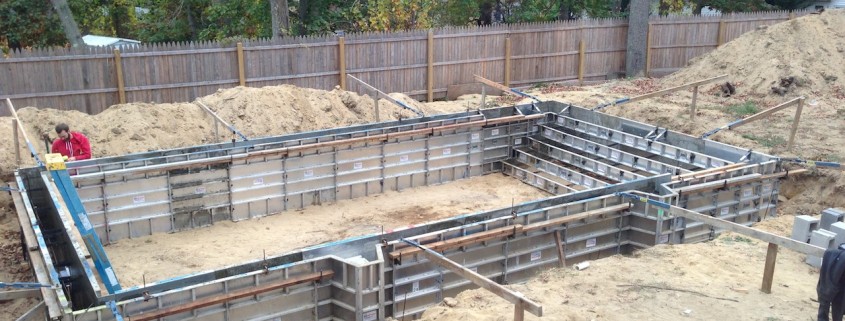
After setting up our aluminum custom pool wall forms our next step is to have a delivery of concrete and fill up the forms.
After removing our forms and installing a pool liner in the pool structure our next step is making a footing 30″ down from the frost line for our patio steps. We then install two rows of cinder blocks starting from 30″ below ground surface. These cinder blocks will act as our step risers. Then we install our tamped RCA base and rebar cage for added concrete slab strength. Most patio installers would be using a much smaller steel mesh or even nothing at all to reinforce there patio slabs but since we are concrete pool builders and believe in going the extra mile we use a full steel rebar cage. This slab, when fully cured, will be easily strong enough to drive trucks on.
Our next step is pouring our concrete slab within our forms and screeting it to a flat surface.
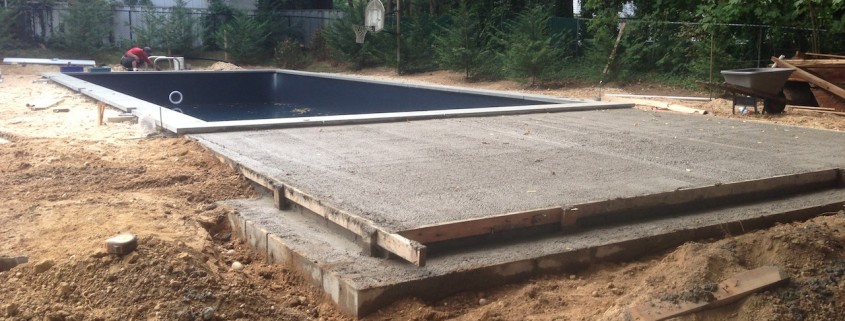
After our slab has cured, we install our thermal bluestone. Here we have created a mesmerizing herringbone pattern with the stone. We can install our stone in many different patterns.
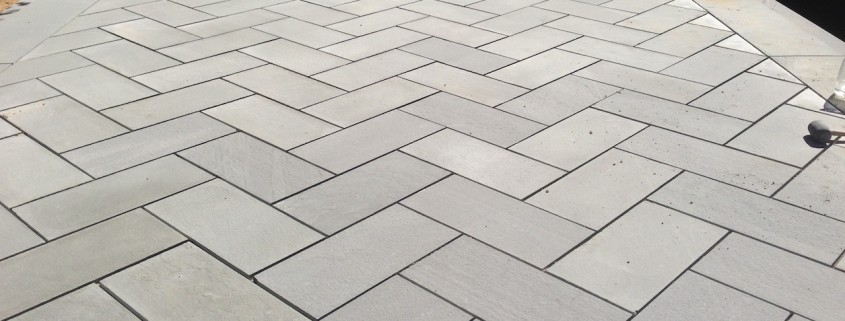 Next we install our step coping. This stone is 16″ wide and 2″ inches thick with a thermal finish on the top and the sides.
Next we install our step coping. This stone is 16″ wide and 2″ inches thick with a thermal finish on the top and the sides.
Next we install a Colonial Blue Wall Stone to veneer our step risers. This is the same stone as our Pennsylvania Bluestone but in its raw unaltered form.
Here is our finished product. This is a custom created bluestone patio by Patrick’s Pools. The stone used within this project is 360 million years old. Between the combination of the natural stone finishes and the black granite pool liner selected, this vinyl pool looks nearly identical to a gunite pool.
Pool maintenance during the Winter?
/in Blog /by Patrick KenneyBelieve it or not, pool maintenance during the off season months is very important to the longevity of your swimming pool!
Patrick Kenney and Southampton pool maintenance
A few simple techniques during the off season can keep your pool in great physical condition with crystal clear water ready to be opened come Spring time.
The most important thing that must be addressed during the Winter is the water level within the winterized swimming pool. Water within a winterized swimming pool should be maintained 14″ below the top of the pool. On average, Long Island gets 28.3 inches of precipitation during the typical months that a swimming pool is closed and winterized. This means that most pools, if untreated over the Winter will overflow. The typical place where water will overflow, would be at the back of the skimmers. This is a bad situation for many reasons. The overflowing water is running down alongside the backside of the swimming pool walls. Depending on the type of pool wall structure this can corrode and weaken the walls of the swimming pool. This traveling water can cause decks to rot and patios to sink around the pool.
Here in the Northeast ice is a killer for swimming pools. In a swimming pool that has a high water level when ice forms, the following are among the potential problems:
- Cracked, weakened, or popped off pool tiles
- Cracked pool light conduits -water inside the pipe was near ground surface and froze and expanded
- Cracked plastic skimmers
- Corners of vinyl liners popping out of the extrusion from ice expansion
- Corners of vinyl liners cracking on older brittle liners
A safety cover is no longer considered “Safe” according to Loop Loc and the APSP (Association of Pool and Spa Professionals) when the water within the pool is not maintained 14″ below the pool surface. A child or animal may wander on to the safety cover. When the water is too high, the individual on top of the cover will sink down well into the water, at a time when it is difficult to get off of the cover because it is sinking in. This can create a drowning hazard, potentially more dangerous than had the pool not been covered at all.
Another problem with water that is too high within a winterized swimming pool is the safety cover sagging down into the pool water. Not only is this shortening the life of your expensive safety cover but it is also allowing leaves and debris to sit on top of the water, or the sun to beat on the water, and start to grow algae and bacteria causing nitrogen buildup within the pool water. This nitrogen buildup ruins your water quality for the next season and for years to come since nitrogen is not removed with normal pool chemicals and filters. This will have a snowballing effect, causing the need for higher chlorine levels to keep algae at bay, which will then shorten the life of all pool surfaces including plumbing, marbeldust finishes, liners, tile grout, and pool heaters, pumps, saltwater sanitizers, and filters.
The moral of this story is it is important to pump the pool water down at least one time during the off season.
At Patrick’s Pools, we do our off season Winter services in 2 parts. First we pump water out of the pool to make sure our water level is 14″ below the surface of the pool before the deep freeze occurs and ice starts to form. Second, starting in late March, we reinstall all pool equipment, test firing the entire system to make sure everything is operating as it should. We also make sure the cover is tightened and free of all leaves and debris. We even clean leaves from the pool area that could potentially blow onto the cover. At this time we also add a small amount of chemicals to the pool water so that the water is crystal clear when we open it in a month or two. A small dose goes a long way when the water temps are low. What this does is it allows us to skip the step of the extra large chlorine “shock” during the pool opening. This step has many benefits. It keeps our customer’s bills lower and it keeps their pools looking newer for longer since the pool is not being exposed to an extra large dose of chlorine at any one time. It also starts the pool off on a great step right from the start of the season. No algae or bacteria has grown in the pool and the pool will quickly be crystal clear, clean, beautiful, and ready to swim in.
Written by Patrick Kenney
Owner of Patricks Pools Inc and member of APSP, NESPA, LIPSA and is an APSP certified building professional of swimming pools.
By Patricks Pools
Sales@patrickspools.com
The key to a crystal clear pool….
/in Blog /by Patrick KenneyBefore reading this please allow me to qualify myself. Personally, I have performed over 10,000 pool cleanings and currently I oversee a company that has performed over 60,000 pool cleanings. Along with thousands of hours of real life experience on the topic, I have also taken many chemistry courses to further understand what is happening within pool water. Although basic pool cleaning and chemistry can be learned within a few days and performed at a relatively decent level, there is a very big difference between pool water maintained by a novice and by a veteran pool cleaner with a good understanding of everything involved in keeping a pool sparkling. For example, I cleaned pools for many years and my last four years cleaning pools I don’t believe one of the pools I maintained had even a one square inch area of algae, ever. This is in stark contrast to the pool industry misconception that once in a while “algae blooms just happen”. Cloudy water, water borne algae, algae that grows on pool surfaces, water that has a chlorine odor, water that burns your eyes, staining on pool surfaces, these are all problems that can be avoided. They don’t just “happen”. There is chemistry behind everything happening in your pool water.
Interested in our pool maintenance? Patrick’s Pools pool maintenance
1. I believe the singular most important and also most overlooked part of keeping a pool crystal clear during the summer months is actually what happens to that water during the 6 months it is not in use. Late fall, Winter, and early Spring is a time when your pool is covered, out of sight and out of mind. Unfortunately this is also the time when your pool water is possibly being tainted permanently. Any time leaves and debris are sitting in your pool water they are destroying the quality of the water essentially forever, or for at least its lifetime within your swimming pool. Leaves sitting in your pool water or on top of a pool cover that drains through to the pool water beneath are releasing ammonia into the water. This ammonia then goes through a biological process called the nitrogen cycle which is as follows:
Ammonia > Nitrite > Nitrate (Do you remember this from 7th grade? Probably not.)
The water is now full of bacteria and nitrogen. Once the water is chlorinated the bacteria will quickly die off but what is left behind forever is water high in nitrogen. There is no such thing as a pool filter that will filter out nitrogen. This water will now be fertile and primed for algae outbreaks for the rest of the time it stays in the pool. This could be a 10 year period. Keep in mind algae is millions of plants, actually more like weeds, since in our pools they are not welcome but can keep “popping” up. The situation that has been created in your pool is similar to adding Miracle Grow to a plant’s soil. Pools with high nitrogen levels may have algae outbreaks even while chlorine levels are within normal ranges or sometimes in bad cases, even with chlorine levels in very high ranges. This is the number one reason for the pool industry misconception that algae “just happens” even with all of the chemicals within range. Actually it didn’t just happen, there was an avoidable reason behind it.
The more leaves and debris sitting in your pool, or draining into your pool, the worse the quality of your pool water forever going forward. Very few people understand this concept and it is a lot to explain to a customer who wants their pool serviced every other week or does not want their pool drained during the winter months and their loop loc cover cleaned of any leaves and debris sitting on top.
The moral of this story:
In order to have high quality sparkling water without using tons of chemicals the actual water quality must be kept high and total dissolved solids kept low. What it takes to make this happen is a minimum of weekly pool cleaning for the entire time the cover is off of the pool. During winter months the pool water must be pumped out and kept well below the bottom of the loop loc cover. No leaves may be allowed to sit on top of the pool cover.
2. Pool water chemistry.
This is an obvious key to a crystal clear pool but the reality is that pool water chemistry is not properly maintained 99.9% of the time. The American National Standards Institute (ANSI) which is the accepted standards maker for swimming pools in the US, calls for public pool water to be tested and adjusted as needed every 3 hours. This is really what it takes for pool water to be maintained properly. Along with the 3 hour rule, there are 10 different chemical levels that I can think of that could be adjusted weekly to perfectly balance pool water, and I have probably missed a few at that. The reality is no one would ever pay to have their pool water tested every third hour, nor would people pay to have ten chemical levels tested and adjusted, not even weekly. It is simply too much.
So as a pool industry professional I have been left with the task of choosing what chemicals I should be using in the swimming pools that my company maintains, all while knowing I’m doing an OK job, but its not really the right job. Its only the best job I can do while charging a rate that people will be willing to pay for. I am not thrilled with this idea but it is an industry standard that I simply have to deal with.
The levels that I believe are most important are:
Chlorine, Ph, Alkalinity, Cyanuric acid, Calcium, Salt, and heavy metals.
If you have all of these levels within range and high water quality, meaning low total dissolved solids and low nitrogen, you will have sparkling water as clear as glass with no chlorine smell or eye irritation. You will also have pool equipment and surfaces that will last. You will have zero chance of any type of algae growing in the pool.
I could explain to you in depth the significance of each of these levels but to a normal person it doesn’t really matter. I will just do a brief explanation of why each level is important.
Chlorine is used as a mild poison to keep our pools clean and clear. In low doses its strong enough to kill any bacteria or plant life (algae), but mild enough that it has little to no effect on people. In fact California water authorities allow for up to a 4 parts per million chlorine level in drinking water, which is more than enough chlorine to keep a pool sparkling. Here is in New York an acceptable chlorine level in your drinking water is 2 ppm which is still enough to keep a pool sparkling. Water authorities use chlorine to sanitize the water you drink and shower with everyday. Chloride is the second most abundant ion in our ocean water.
PH is short for potential of hydrogen. Here in New York the PH level of your pool has a tendency to drop over time for two main reasons. The PH of our rain water is quite acidic, I believe caused by the pollution produced by NYC and New Jersey industries. This acidic rain water lowers our pool water PH levels each time it rains. In different parts of the country there is an opposite effect. The second major reason for the downward PH tendency of our pools is the Cyanuric acid used as a stabilizer within the typical “hockey puck” chlorine tablets that are so common. PH if left unchecked here in NY will spiral down to levels low enough to destroy all pool surfaces and anything metal that touches the pool water. The first things to be destroyed will be marbledust finishes and pool heaters, which are not cheap items. A low PH level will cause pool surface erosion, pools to leak, and will cause burning eyes.
Alkalinity is a PH stabilizer. It raises PH slightly and does not allow PH levels to quickly rise and fall. Its also is commonly known as Sodium Bicarbonate which along with being a pool chemical doubles as Baking Soda for our food, laundry, and teeth. It also acts as a medication to raise the ph levels of our stomachs to prevent ulcers and heartburn. This is the most important chemical in my eyes. I’d rather low chlorine and a pool that turns green over low alkalinity and a pool that self destructs any day of the week. PH and alkalinity are the most overlooked chemicals by uneducated pool cleaners and homeowners. You can keep a pool clear without these, but the pool will have severe long term damage.
Cyanuric acid is used as a chlorine stabilizer. It allows the chlorine to stay in your pool water long term and not just dissipate within a few hours. A cyanuric acid level that is too low will cause your chlorine level to drop rapidly. It will also require you to use a large quantity of chlorine to keep the chlorine levels high enough for a full week. A high level of cyanuric acid will cause your chlorine to be too stable and ineffective. With a very high level of cyanuric acid it is possible to have a chlorine level of 5 times the needed amount and still have a pool filled with algae. “Hockey” puck chlorine tablets contain cyanuric acid in them. Each week when the chlorine tablets are added the cyanuric acid level climbs. This is a chemical level that does not fall on its own. Since this level continues to climb weekly with a pool that uses chlorine tablets, often in August uneducated pool cleaners will run into many algae blooms and not know the cause. They believe that the algae has become immune to the chlorine since their chlorine counts are at the correct level. The problem really is that the cyanuric acid level is high which has made the chlorine less effective.
Calcium is an alkaline earth metal that is especially important in gunite pool water. In much the same way low calcium levels in human beings causes osteoporosis and erosion of bones, low calcium in gunite pool water will cause erosion of marbledust finishes. Pool water seeks to have a calcium level of 200-400 ppm. If it has a level lower than this it will take the calcium from anything that it touches that actually contains calcium within it. This includes all concretes and stone. A low calcium level in a pool with a marbledust finish will have disastrous results.
Salt levels in saltwater chlorine generated pools need to be kept between approximately 2800-3800 parts per million, depending upon the brand of generator. The generator charges the pool water within the salt cell splitting the NaCl ions into Na (sodium) and Cl (chlorine). This result is an unstabilized chlorine which is undetectable by human taste or smell, and the resulting water causes no irritation to human skin or eyes.
Heavy metals that typically cause problems in pools on Long Island are iron and manganese. Certain areas on Long Island have especially high iron levels and homeowners can not use their tap water to fill their pools without a pre-fill filter. Quogue, parts of Hampton Bays and Southampton have the highest amount of iron in their tap water that I know of. High iron levels cause brown stains and brown or off-green water. Copper, which is often used as an ingredient in algaecides can also cause blue water and green/blueish to black staining but the resulting stains are much less offensive than iron staining. Heavy metals can be filtered out or sequestered by a number of metal removing chemicals.
3. Using a pool brush is very important to maintaining an algae free pool. Wall borne algae is much more resilient to algaecides and chlorine than water borne algae. Simply adding chemicals and not brushing algae off of pool walls will not kill the algae.
By Patricks Pools
Sales@patrickspools.com
Let’s talk about a pool design with some thought behind it.
/in Blog /by Patrick KenneyLet’s talk about a pool designed with some thought behind it.
How about a pool in the Hamptons that can have its heater turned on from Manhattan so that the water is warm when you arrive? How about a pool that automatically sends heated water to the bottom of the pool so that it heats twice as fast and burns half the fuel? How about a pool that when you are done with the heater automatically sends the return water to the jets at the top of the pool to keep the pool clean while you are away from it? How about a pool that automatically drains when it rains too much, or a pool that automatically fills itself when it needs more water? How about a pool whos sanitizer level will remain constant for a month at a time even without anyone checking on it? How about a pool where you can swim under water all day long with your eyes wide open without even a hint of eye irritation? Or a pool that with the touch of one single button you can turn on a heater, turn off a waterfall, and turn on your spa jets and blower? How about a pool that stays twice as clean and uses 1/10 the electricity of a standard pool on Long Island? How about a pool that with the touch of a button a completely hidden cover gracefully slides across its top to keep heat in and leaves out?
These are the types of pools Patrick’s Pools Inc. builds. We are completely dedicated to building the best pools possible.
By Patricks Pools / Patrick Kenney Southampton pool builder
Sales@patrickspools.com
Save $900 a Year with High Efficiency Hybrid Pool Pump
/in Blog /by dodadminDid you know that a traditional pool pump, like a Hayward Super Pump, uses the exact same amount of electricity as a full sized refrigerator running with its door left wide open 24 hours a day? Very hard to believe, but this is a fact! This costs Long Islanders over $1000 on average per year.
[button link=”http://patrickspools.net/wp-content/uploads/2011/04/rebate-pool.pdf”]PSEG Pool Pump $450 Rebate[/button]
Patrick’s Pools is a certified high efficiency pool pump installer and dealer for PSEG. We will install your high efficiency pool pump and do all necessary paperwork for you to receive a $450 PSEG rebate check.
The solution is here!
 Hybrid pool pumps are possibly the biggest breakthrough in the history of the pool industry. They use the same breakthrough 6-pole motor technology as our hybrid cars that are achieving 50+ mpg. These pumps are 90% efficient compared with regular pool pumps and will save approximately $900 per year in electricity on Long Island using today’s PSEG rates.
Hybrid pool pumps are possibly the biggest breakthrough in the history of the pool industry. They use the same breakthrough 6-pole motor technology as our hybrid cars that are achieving 50+ mpg. These pumps are 90% efficient compared with regular pool pumps and will save approximately $900 per year in electricity on Long Island using today’s PSEG rates.
The advanced motor produces far less heat and vibration than a standard pool pump. It also operates at a much slower speed. This combination of factors gives them an outrageous 20-year life expectancy, meaning they will save an average of $18,000 over their lifetime. They also have the ability to move three times the gallons per minute of water compared to a traditional pool pump, meaning they will keep your pool much cleaner. Certain models even poses a built in SVRS (safety vacuum relief system) meaning the pump will shut down in the event a child was trapped on a main drain. These pumps are also the quietest pumps available.
These pumps are an absolute no-brainer and should be on every pool. Besides saving our environment they will also save you tens of thousands of dollars over their lifetime, and keep your pool cleaner. Patrick’s Pools is an expert at installing and programming these unbelievable pool pumps. The sooner you switch to a hybrid pump the sooner you will start saving $900 a year on electricity.
By Patricks Pools Patrick Kenney of Southampton
Sales@patrickspools.com

